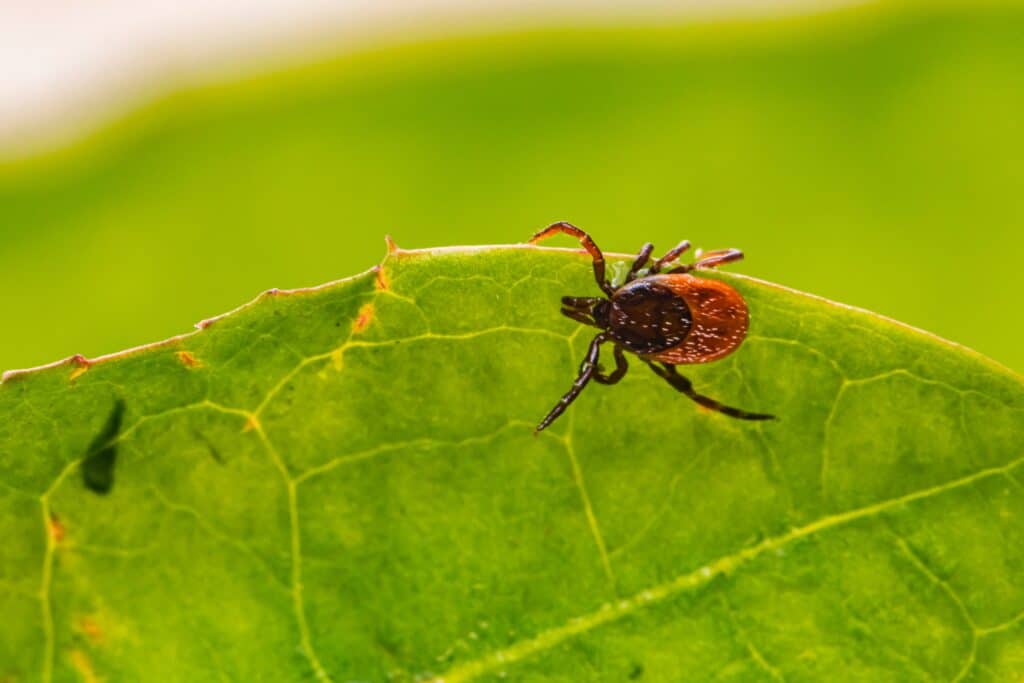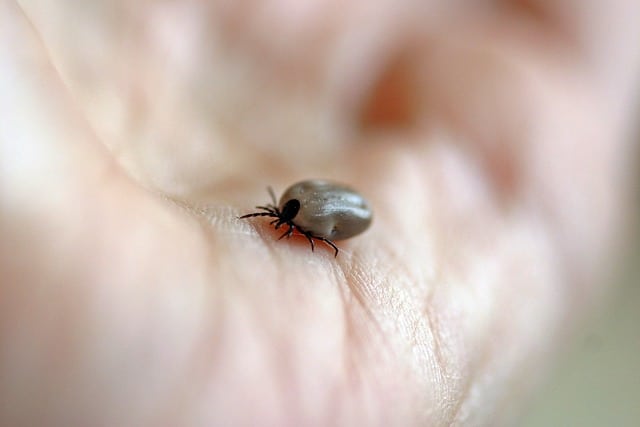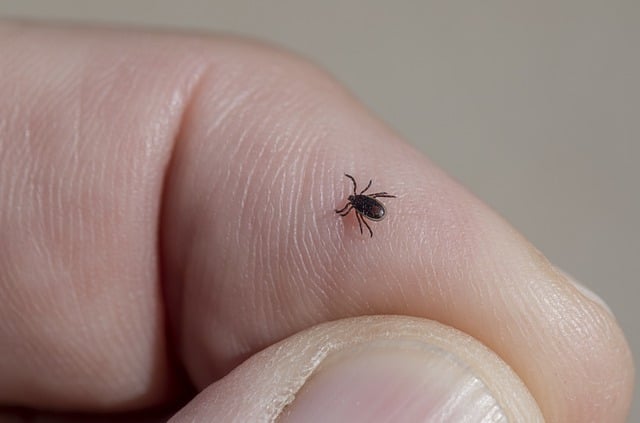Camping and hiking will inevitably expose you to more critters and pathogens, including parasitic ticks.
In fact, specific regions of North America are hotbeds for ticks. As a result, campgrounds and parks actively post warnings about ticks and promote tick awareness in the hopes to keep bites and disease transmission low.
For that reason, as outdoor enthusiasts, it’s important to:
- take the necessary preventative steps to keep ticks at bay
- continually check for ticks
- know exactly how to remove a tick while camping
Article Contents:
What Are Ticks?

Chances are that you’ve probably grown up hearing all about ticks. From a young age, we’ve been told that we need to check for and remove ticks if we go into the forest or walk through tall grass.
But what exactly are ticks?
Ticks are categorized as parasites, which means that they latch onto warm-blooded animals and feed from their host. Biologically, ticks are classified as arachnids since they are 8-legged creatures just like spiders.
Depending on the stage of their life cycle, ticks can be as small as a grain of sand (larvae stage), the size of a chilli seed (nymph stage), or the size of an apple seed (adult stage) [Reference].
After feeding on their host and engorged with blood, ticks can be as large as a blueberry!
Common Species of Ticks
There are a whopping 900 species of ticks found around the world [Reference].
However, the two most common species of ticks to look out for while camping and hiking are the American Dog Tick and Blacklegged “Deer” Tick.
Why Are Ticks Dangerous?

In nature, it’s usually the microscopic organisms that are the most harmful and the hardest to protect against. Unfortunately, ticks are natural harbours for life threatening bacteria and viruses. That’s why it’s critical knowing what damage they can do.
Like most other parasites, ticks are dangerous to humans as well as other animals. They feed on blood, carry and transfer diseases, and are dispersed in areas humans frequent. So, the odds of a detrimental tick encounter are somewhat high.
Both the American Dog Tick and Blacklegged Tick can carry and transmit harmful pathogens, including tularemia, anaplasmosis, babesiosis, Rocky Mountain spotted fever and Lyme disease.
These infections can cause serious illness if left untreated. So, whether you’re in the backcountry or in your very own backyard, you need to protect yourself and watch out for ticks!
Common Myths About Ticks
Ticks are often reported on by the media when spring and summer roll around. As the temperatures start to climb, pet owners also get a lecture by their vet on how to protect the animals from ticks.
However, with all the information available, sometimes myths precede facts. So, let’s run through 4 common myths about ticks.
1. Ticks are Only Active in the Summer
False – Ticks can be active throughout the year, even through the winter months. When the ground temperature exceeds 4oC, ticks become active [Reference].
Personally, we found this out the hard way. Two fully engorged ticks fell off our dog in December during a couple of weeks of mild temperatures in downtown Toronto. And, this happened after only going to local parks in the city.
The lessons we learned was to use tick prevention medication for our dog year-round!
2. You Should Burn off a Tick
False – Burning a tick won’t make it automatically detach from the skin. In fact, burning a tick could cause it release more potentially infected fluid into the skin [Reference].
An effective technique for tick removal is using tweezers or a tick removal device.
3. All Ticks Carry Lyme Disease
False – Not all ticks carry diseases and only infected blacklegged ticks are known to carry Lyme Disease.
The number of ticks infected with Lyme disease is highly dependent on location, with some regions having an infection rate ranging from 1% to 50% of the population of ticks [Reference].
So, your odds of actually contracting Lyme disease are relatively low.
4. Tick Bites Are Painful
False – Tick bites are typically painless. Tick saliva contains histamine-blocking compounds that prevents itchiness, redness and inhibits blood flow.
That’s why it’s important to conduct a visual tick check after being outdoors!
How to Properly Check for Ticks

After spending time outdoors, especially if you’ve been walking in a forest or through tall grassy areas, it’s important to check your clothing and body for ticks.
- Ticks can attach themselves to anywhere on the body.
- They can crawl across untreated clothing, and where ever there is exposed skin, a tick can latch on and start the feeding process.
Working your way from your hands and feet, slowly scan your skin for anything attached. Ticks can be as small as a pin head.
Keep in mind, there are tick attachment hotspots on the body – the head and ears, underarms, belly button and waist, between the legs, and the back of the knee [Reference].
It’s important to spend extra time checking these areas!
To properly check for ticks, it’s best to have someone scan your body for you. They can better look for and identify ticks in hard to reach and see places. If you’re alone, a handheld large mirror works best.
How to Properly Remove a Tick

Ticks attach themselves to humans by means of their mouthpart. A tick’s mouthpart consists of tiny backwards pointing serrations that help it dig into the skin and allow it to stay attached.
If you’ve found a tick attach to your body, there’s no need to panic. You just need to use the right tool and technique to remove it properly.
Removing an attached tick is fairly straightforward. Use either a tick removal tool, or a set of fine-tipped tweezers so that the entire tick, mouthpart included, is removed.
Once removed, clean the bite area with rubbing alcohol or soap and water. The removed tick can then be disposed.
Pro-tip: In some regions a removed tick can be taken to a local pharmacy for testing.
How to Use a Tick Removal Tool
- Place the tool onto the skin centered over the tick
- With steady, even pressure, slide the tool along the skin such that the tapered section of the tool is in-line with the tick head
- The tapered section of the tool will grip the tick head and mouthpart
- Pull the tool parallel to the skin in the direction directly away from the tick head
- Do not twist or lift the tool away from the skin
How to Use Tweezers to Remove a Tick
- Using fine-tipped tweezers, grasp the tick as close to the skin as possible
- Pull the tick away from the skin without twisting
- If parts of the tick break off and are left attached to the skin, use the tweezers to try to remove them individually
How to Prevent Tick Bites
Ticks can live and thrive in a variety of climates, but tend to be found in densely wooded and forested areas, tall grasslands, leaf litter, and among low laying brush. Even walking off an established hiking trail can expose you to hidden ticks.
In the suburbs, they can be found strewn across lawns or gardens. Even parks nestled in the heart of a major city can be host to a thriving tick colony.
In most cases, it would be quite difficult to avoid all the places ticks can be hidden amongst. So, what should you do to protect yourself and prevent ticks bites?
Well, it’s a good idea to implement tick bite preventative measures, which includes using specific chemicals to stop tick bites from happening.
Insect Repellents for Ticks
When it comes to skin-safe tick repellents, the CDC recommends using insect repellent sprays that contain either DEET, picaridin, IR3535, lemon eucalyptus oil containing trans-p-methane 3,8-diol (PMD), or 2-undecanone [Reference].
DEET
For most campers and hikers, DEET is very commonly used to battle endless swarms of mosquitos. Thankfully, DEET can also be used to fend off ticks!
- A laboratory study was conducted which showed that a spray containing at least 30% DEET had a 80-100% tick repellency [Reference].
PMD
Lemon eucalyptus oil containing the active ingredient PMD is a DEET-alternative skin-contacting spray which has shown to be highly repellent against ticks.
- PMD repellency ranges from 100% for 5 minutes, and up to 85-91% after 48 hours [Reference].
Tick Spray for Clothing
Skin-safe repellents only work on areas of the skin where the spray was applied. And, since ticks can mobilize and attach to unprotected areas of skin, additional protection might be required.
Another effective technique for preventing ticks from attaching to your body is wearing chemically treated clothing, specifically permethrin treated clothing.
Permethrin
Permethrin is a synthetic insecticide that has shown to be highly effective against ticks. It works by physiologically effecting a tick’s feet (hot feet) which causes them to detach.
- In a field test, clothing dipped in or sprayed with Permethrin was found to provide 100% protection against all life stages of ticks [Reference].
So, if you plan on spending extended periods of time in tick infested areas, then wearing factory applied permethrin impregnated clothing is highly recommended.
You can also treat your own clothes at home with sprays containing permethrin. Premium Insect Repellent from Sawyer is a safe and easy way to protect your clothes, shoes, tent and gear.
Just remember, the layer of protection lasts up to 6-weeks, or through 6 washes, whichever comes first, so re-application is necessary!
This article contains affiliate links, which help support this blog at no cost to you!
